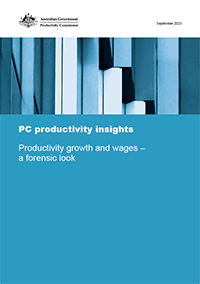Productivity growth and wages – a forensic look

PC productivity insights
This paper examines the evidence on whether wages have kept up with labour productivity in the past few decades.
We find that in all industries except for mining and agriculture – which account for over 95% of employment – productivity growth and wage growth are correlated.
Our research shows that mining and agriculture – which account for about 5% of total people employed across the economy – have exhibited wage decoupling and skew the national average significantly.
- Over the long term, for most workers, productivity growth and real wages have grown together in Australia. If productivity growth exceeds wage growth over the long term, this is referred to as wage-decoupling.
- Mining and agriculture – which account for about 5% of total people employed across the economy – have exhibited wage decoupling and skew the national average significantly.
- In all industries outside of mining and agriculture, which account for over 95% of employment, the difference between productivity growth and wages growth has been relatively low. Outside of mining and agriculture, more than half of the sectors examined experienced zero or negative decoupling. As a consequence, the share of income going to that 95% of labour has declined by less than 1 percentage point over the past 27 years.
- Productivity growth is the main driver of real wage growth.
- For 95% of the labour force, had we been able to maintain productivity growth from 1995 to 2023 at the 2.2% average level seen in the 1990s, then real annual average incomes would today be $25,000 higher.
- For the same 95% of the labour force wage decoupling since 1995 means that average real annual incomes are about $3,000 lower than they otherwise would be.
Paper
- Preliminaries: Cover, Copyright and publication detail, Contents and Acknowledgements
- Key points
- Introduction
- The link between wages and productivity weakens in the mining and agriculture sectors
- Understanding decoupling for the 95%
- Decoupling has limited impact on Australians’ income
- The aggregate and the sectoral – a conclusion
- References
Appendices
- Appendix A – Making the right data choices
- A.1 The Commission’s preferred measure of wage decoupling
- A.2 The Commission’s preferred estimate of wages
- Appendix B – Methodological details
- B.1 Splitting gross mixed income (GMI) between labour and capital
- B.2 Estimating aggregate labour productivity and the gross value added (GVA) deflator without mining
- B.3 Decomposing the change in the labour share of income
- Appendix C – Mining and agriculture affect on the aggregate results
- Appendix D – Wage decoupling and other economic indicators
- D.1 Wage decoupling and the labour share of income
- D.2 Wage decoupling and the terms of trade
- D.3 Wage decoupling and inequality
- Appendix E – Estimates of long-run decoupling from 1959–60
- E.1 Methodology
- E.2 Decoupling from 1959-60 to 2021-22
- E.3 The labour income share from 1860 to 2021
- References
We value your comments about this publication and encourage you to provide feedback.


